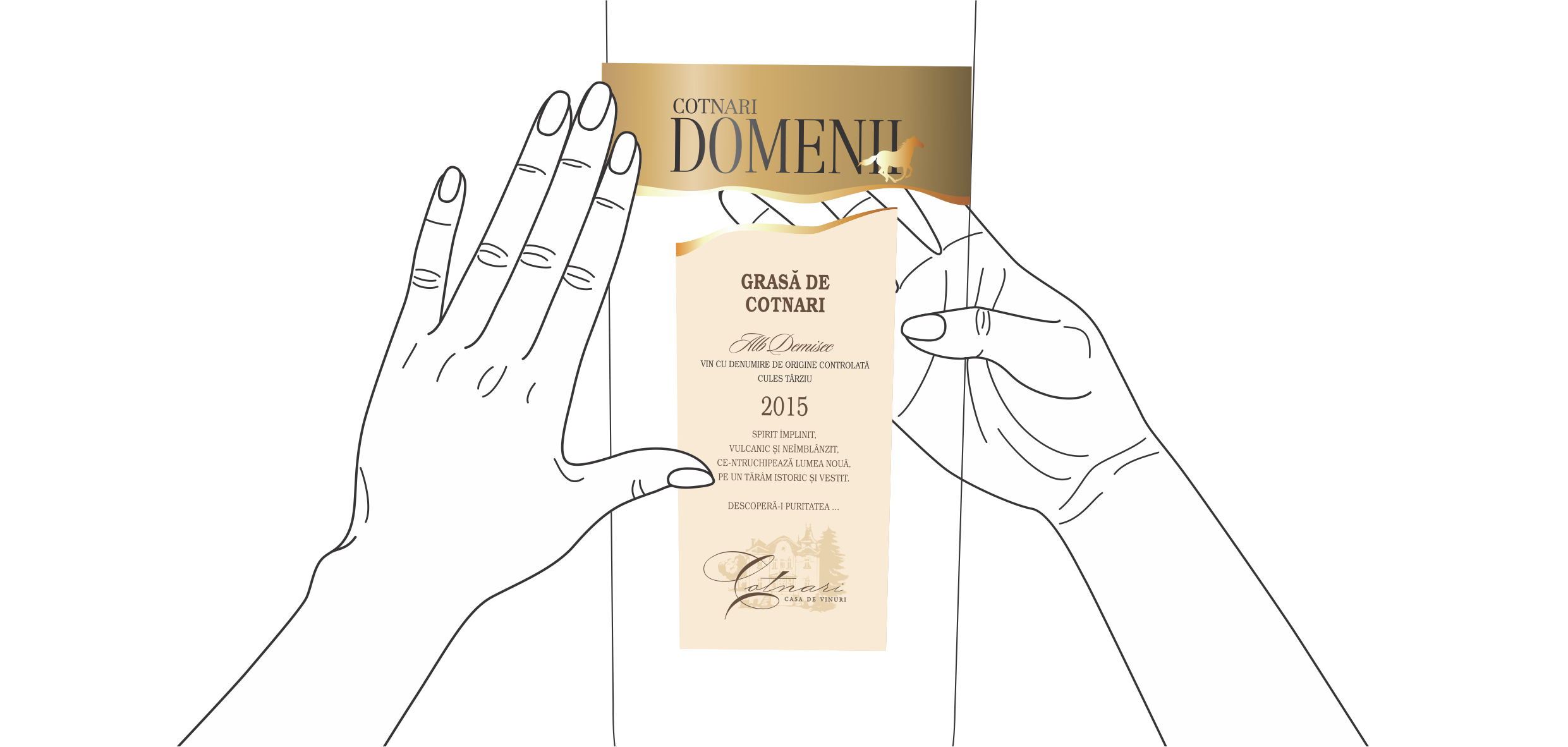
The Cotnari vineyard is part of the wine-growing region of Moldavia’s Plateau, being one of Europe’s most famous vineyards, with a history of about 2,000 years and an area of 1,750 hectares, combining the natural factors (relief, climate, soil) with that of human factors (folk traditions, know-how, etc.).
The microclimate is characterized by average annual temperatures of 9 degrees Celsius, 475 mm annual average rainfall and dominant winds from the NW, SE, S, constituting an environment conducive to the cultivation of the vine and the production of quality wines. Cotnari Wine House is an ambitious project, started in 2007, by setting up new plantations in the vineyard, made up of the traditional Grape Cotnari, Tamaioasa Romaneasca and Feteasca Alba varieties, joined by Busuioaca and Feteasca Neagra
.
The presence of the Feteasca Negru variety in the Cotnari vineyard is not an element of innovation. In the ceramic pots of the Cucuteni culture, a town located 11 km from Cotnari (one of the most blooming Neolithic civilizations between 5500 and 2750 before our era), there were grapes and traces of what seems to come.
According to the documents in the National Archives (Arch. St. Bucharest, dossier 1012, p. 8), in 1899 the head of the viticulture service of the Ministry of Agriculture, when traveling to France, visited the agricultural schools in Montpellier and Ecully (Beaujolais). The directors of these schools expressed the wish that “they would be happy to have some of our main Romanian varieties and vines in their school collections.” Returned to Bucharest, the Romanian delegate proposes to the Ministry to send 50 cattle from our main varieties from Cotnari, Odobeşti, Dealul Mare, Drăgăşani and Mehedinţi vineyards. The wine Inspector from Cotnari reported that, to be sent to France they had “absolutely genuine” string of the following varieties: Grasă de Cotnari, Fetească Albă, FETEASCĂ NEAGRĂ, Coarnă Albă, Coarnă Neagra, Mustoasă, Plavae, and Galbenă. From Cotnari, the following “absolutely authentic, indigenous, verified and authentic” vines were sent to France: Grasă de Cotnari, FETEASCĂ NEAGRĂ, Fetească Albă, Plavae, Mustoasă, and Galbenă.
So we can say, correctly, that Feteasca Neagră vineyard was REPLANTED in Cotnari, and not PLANTED.
A very important aspect, which is to be appreciated, is the fact that in Cotnari vineyard the tradition was preserved, and only old Romanian varieties can be found Grasă de Cotnari, Tămâioasă Românească, Fetească Albă, Francușă, Busuioacă, and Fetească Neagră.
The Cotnari Wine House is located in Cîrjoaia, at Vlădoianu Castle, built in 1901 by the former Governor of the National Bank, boyar Vasile Vladoianu, along with his wife Raliţa Bals, descendant of the boy Balş. The building of the castle used an Italian project and materials brought from Italy. As time went by, the domain was assigned various destinations: during the Second World War it was used by the Russian army as a hospital and between 1945 and 1950 it functioned as an orphanage. After 1950, the CAP acquired it being then taken over by IAS Cotnari. In 2000 he was returned to the heirs of law from which he was subsequently acquired. At present, over Vlădoianu Castle has left its mark the passage of time, but in the future it is aimed at realizing a unique project of restoration of the domain, which will give it the brilliance of the time, specific belle époque.
The surface exploited by Cotnari Wine House is composed of Fetească Neagră – 100 ha, Busuioacă – 75 ha, Tămâioasă Românească – 75 ha, Grasă de Cotnari – 50 ha and Fetească Albă – 50 ha. Being a premium producer of quality grapes, Cotnari Wine Plantations have been set up with state-of-the-art technology, aiming at a low plant density (3646 plants per hectare), a great distance between rows, m) which allows efficient air circulation and modern works. The vineyard works are carried out so that the amount of grapes harvested per hectare does not exceed 6 tons (Grass of Cotnari, Tămâioasă Românească, Fetească Albă, and Busuioacă) and 5 tons (Fetească Neagră) with a minimum of 230 grams of sugar.
The completion of Vlădoianu wine cellar, located behind Vlădoianu Castle, is the first stage of the wine investment plan of the Cotnari Wine House. Located on the site of the old wine cellar, where the Vladianu boyar produced the wine obtained from the grapes harvesting about the 50 hectares he managed, and the 15 meter deep cellar, 6 meters high, with an area of approximately 200 square meters, where it stores the wine produced, Vlădoianu wine cellar is equipped with state-of-the-art technology for vinification of red grapes.
Although the initial investment plan provided for the construction of a new wine cellar within the Vlădoianu domain, endowed with state-of-the-art technologies in wine grape vinification, September 2013 brought a major but beneficial change by purchasing an old wine cellar: Axinte Wine Cellar.
John Axinte, a well-known lawyer and former prefect of Iasi, “skilled vine grower “, acquired in 1933, from the famous soprano Hariclea Darclee a 3-rope vine and 53 rods for the purpose of winemaking the grapes obtained.
At that time, specific to Cotnari vineyard, it was the vinification of traditional grapes by families with small vineyards. Among these families, prior to the acquisition made by Ioan Axinte, famous in the Vineyard, was the Terente winemakers’ family, who had come to sell the “wine bottle”, whose couples remained unknown at a price of 700 lei, to the House of Commons of Egypt and Ethiopia.
In a short period of time after the acquisition of the vineyards by Ioan Axinte, [according to the 1969 accounts, published in the Chronicle of the Cotnaries, (Bucharest, 1971, p. 214)], after an exceptional year, when the harvest took place late, and the stum obtained was processed in a way unknown, the coupage of three traditional varieties of the famous vine grower was sold at a price of 1500 lei (about 10 $) per “bottle”, being searched as “grass of cure”.
This considerable increase in quality, in such a short time, made him famous in the Vineyard, being elected in 1936 as vice-president of the Cotnari Cooperative Society, which aimed at vinification under higher technical conditions of the grapes, as well and the capitalization of wine at more advantageous prices.
Thus, the well-known lawyer and former prefect of Iasi, who soon became a skilled winemaker, had a decisive role in increasing the quality of the wines produced in the Cotnari vineyard, a mission which the Cotnari Wine House uses for the future.
The history of the winemaker was the decisive reason for the acquisition of Axinte wine cellar, the Cotnari Wine House, aiming to combine modernism with the long experience and history of the place.
Although at present the Axinte wine cellar is in an advanced state of deterioration, at the end of the investments, here will be obtained white and rose wines, but also sparkling and distilled wines.
The products found in the two varieties of Cotnari Wine House (Cotnari Domenii and Colocviu) combine innovation (the shape of bottles, labels, hoods, contents) with the traditionalism (the history of the wineries, the Romanian native varieties) fusion specific to the Cotnari Wine House.











